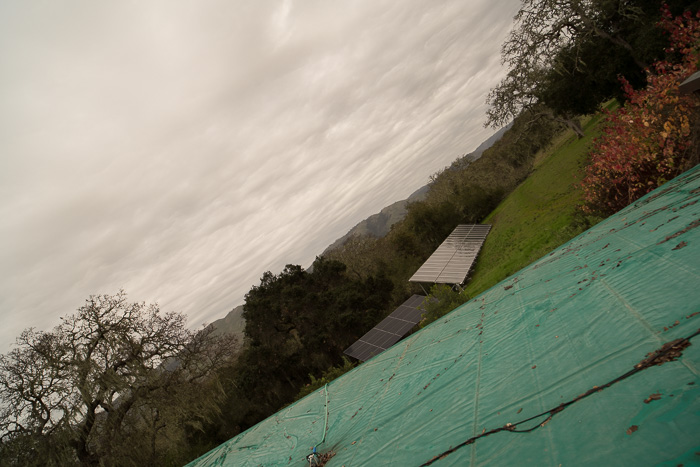On Wednesday, the big brown truck brought a Zeiss Loxia 21mm f/2.8 lens for the Sony alpha 7x cameras that I’d ordered on announcement day back in October. I tore into the package like it was Christmas. No pouch, which is OK with me, since I use the Domke wraps or climbing chalk bags, and the pouches that come with the lens just gather dust, and I never can find the right one when it comes time to sell the lens.
The lens has a nicely-made, not very large, reversible lens hood. Like most of the Zeiss Zeiss (as opposed to the Sony Zeiss) lenses, the hood is metal. I hate that. While it feels nice in the hand, it weighs more than a plastic hood, and you run the risk of damaging it if you are clumsy like me. When you drop a plastic hood like the Nikon or Sony ones, it just bounces; when you drop a metal Zeiss hood, it is likely to bend in a way that keeps you from attaching it properly. Then you’ll find out that Zeiss is not shy at all about charging big bucks for replacement hoods.
When the hood is reversed, it sticks up past the front of the lens far enough that it’s hard to put the lens cap on and take it off. So the right way to get ready to take a picture is to take the hood off, take the lens cap off, then put the hood on. When you’re ready to stow the hood, take the hood off, put the lens cap on, then put the hood on backwards. This is not the way I usually do things, but I think I’m trainable.
The aperture ring rotates through 90 degrees, which is a lot, That feels a little weird, but makes the third-stop detents pleasantly far apart. The focusing ring also rotates through 90 degrees, which, while pretty much standard for rangefinder camera lenses, is pretty tight for a mirrorless one that focuses to under a meter. The typically optimistic depth of field marks are thus jammed together. While not a crippling flaw, it seems that the rangefinder heritage of this lens is in its DNA a bit more than it should be.
There’s only a narrow piece of the lens barrel between the aperture and focusing rings, and that’s what you want to grab when you mount and unmount the lens to the body. It’s hard to do, and the fact that the mount is very stiff doesn’t make it any easier. I end up rotating the other rings so that they’re at whichever stop is appropriate ofr mounting or unmounting, but I’m a bit nervous about stressing them in that way.
I can’t say enough nice things about the way this compact 21mm lens handles on the a7RII. It’s like they were made for each other. The lens is actually too short to use the Pete Souza grip until you put the hood on it. The lens, camera, and a RRS plate (I’m not using the a7RII L plates much, just the under camera plate) fit together in a package that just feels right.
For someone who spends most of his time with third party lenses mounted to a7x cameras with dumb adapters, the convenience of a native lens is nice. Twist the focusing ring, and you get automatic finder magnification. The metadata fields are all full. Lightroom knows what lens profile to apply. Very civilized.
Yesterday was a gray day, but I still used it to compare the Loxia to the Zeiss 21mm f/2.8 ZF.2 mounted to the a7RII with a Kipon adapter. Incidentally, for the first time in my experience with Kipon adapters, the stars aligned wrong and I could quite focus to infinity wide open. Also incidentally, when I put a Novoflex adapter on the Zeiss 21 DF.2, it wouldn’t lock. That’s also the first time that’s happened to me. The Zeiss 21 has locked with every other adapter I’ve used it with, and the adapter has locked with every other lens I’ve used it with. Go figure. The inability of the ZF.2 to focus to infinity ruined the wide aperture pictures for comparison purposes, so I’m not going to show blowups to you here.
A few overall shots:


The F-mount lens vignettes a bit more, which is a surprise to me.


Still a bit more vignetting.


Pretty much the same, and the same for all the narrower apertures.
Center sharpness, with development in Lr 2015 with lens correction off, and default settings except for WB set to cloudy.

This is fine performance.

A hair sharper.

Sharper yet.

Not as sharp as f/5,6, but fine.

Softening up.

Pretty soft.

Really soft. I’m a little surprised to find f/22 on this lens.
In the corner. By the way, I focused in the corner for the below images, but the ones where I focused in the center look the same.

A bit soft, but definitely usable.

Fine.

Better.

Pretty much the same. The sweet spot over all for this lens appears to be at f/5.6 and f/8.

Losing a bit of sharpness.

Soft.

Really soft.
I’m impressed. Next up, a few shots from this morning, with the sun out.
[…] This is a continuation of the Loxia review that starts here. […]